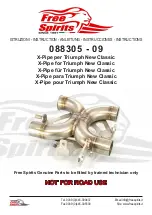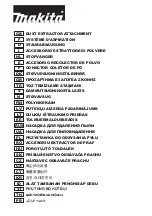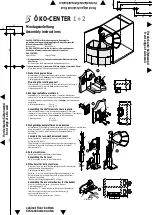
- 16 -
General safety instructions
The vehicle owner is responsible for ensuring that his or her field
of view and hearing are not impaired by the load or the condition
of the vehicle. It must be ensured that the vehicle and load are
in accordance with regulations and that vehicle road safety is not
impaired by the load.
The required lighting and lighting systems must also be present
and operational during the day.
These mounting and operating Instructions contain the general
approval of the bicycle rack for trailer hitches and must always
the kept in the vehicle when the rack is mounted.
Observe the legal regulations regarding use of the bicycle rack
in the country of use.
Attention
The operating steps and safety instructions described in these
mounting and operating Instructions must be adhered to.
The bicycle rack for the trailer hitch is intended only for
transporting bicycles. The bicycle rack is not suitable for
use on rough terrain.
All screw connections and attachments of the bicycle rack and
the bicycles must be tested before assembly, before every trip
and during lengthy trips to ensure they are sitting firmly, and
they must be retightened if necessary. This check must be
repeated at regular intervals regardless of road conditions.
During the trip, the driver should check the bicycle rack and
bicycles for any shifting/changes in position by glancing in the
rear view mirror.
If changes are noticed, proceed to the next possible stopping
area at reduced speed and retighten the screw connections
and attachments of the bicycle rack or bicycles.
If these instructions are not followed, the bicycle rack and/or the
load may free themselves from the vehicle and cause injury to
you and other persons, or may result in an accident.
Attention
Do not use lubricants on the pre-mounted screw connections.
This could cause the screw connections to loosen and the
bicycle rack together with the mounted bicycles may free
themselves from the vehicle; this may cause injury to you
and other persons, or may result in an accident.
Attention
If the load (the bicycles) extends more than 40 cm beyond the
outer edge of the lit area of the side-marker lights or tail lights
of the rear rack system, the load must be marked at most 40 cm
from the edge and at most 150 cm above the road surface,
at the front by a white light and at the back by a red light.
Separately mark the bicycle wheels extending out laterally
during transport.
When driving at night, cover the rear lights and reflectors of the
bicycles to prevent confusion with the rearward-facing-vehicle
lighting and to avoid hindering or confusing other road users.
Failure to do so could result in an accident
Attention
Before starting a trip, check that the lighting system is
functioning correctly. When the rear fog light on the bicycle
rack is switched on, the rear fog light of the vehicle must be
switched off, i.e they must be illuminated at the same time.
In vehicle models whose type approval was initially issued after
1 October 1998, the mounted rear-rack system and the load
must not cover the third brake light of the vehicle. The third brake
light of the vehicle must be visible: on the left and right, relative
to the longitudinal vehicle axis, at a horizontal angle of 10°;
at the top relative to the top edge of the lamp, at a vertical-angle
of 10°; and at the bottom, relative to the lower e-dge of the lamp,
at a vertical angle of 5°. If these values are not met, a “third”
replacement brake light must be installed.
Failure to do so could result in an accident
Attention
The mounted bicycle rack and bicycles alter the driving and
braking characteristics as well as the lateral wind sensitivity
of the vehicle. A maximum speed of 130 km/h must not be
exceeded.
Do not cover the bicycles with tarps, protective covers or
s imilar as this greatly influences both areas exposed to the
wind and driving behaviour.
Slide any heavy cargo in the luggage compartment as far
forward as possible to avoid excessively loading down the
rear of the vehicle.
Always adjust your driving style to the road, traffic and w-eather
conditions and exercise special care when driving with a loaded
bicycle rack.
If these instructions are not followed, the bicycle rack and/or the
load may free themselves from the vehicle and cause injury to
you and other persons, or may result in an accident.
Attention
If the vehicle is equipped with an electrical luggage compartment
lid, allow for the necessary clearance when mounting the
bicycle rack. If possible, the electrical luggage compartment
lid should be de-activated and operated manually.
Remove the bicycle rack before using automatic car washes.
Otherwise, the bicycle rack, the vehicle and/or the car-wash
could be damaged.
















































